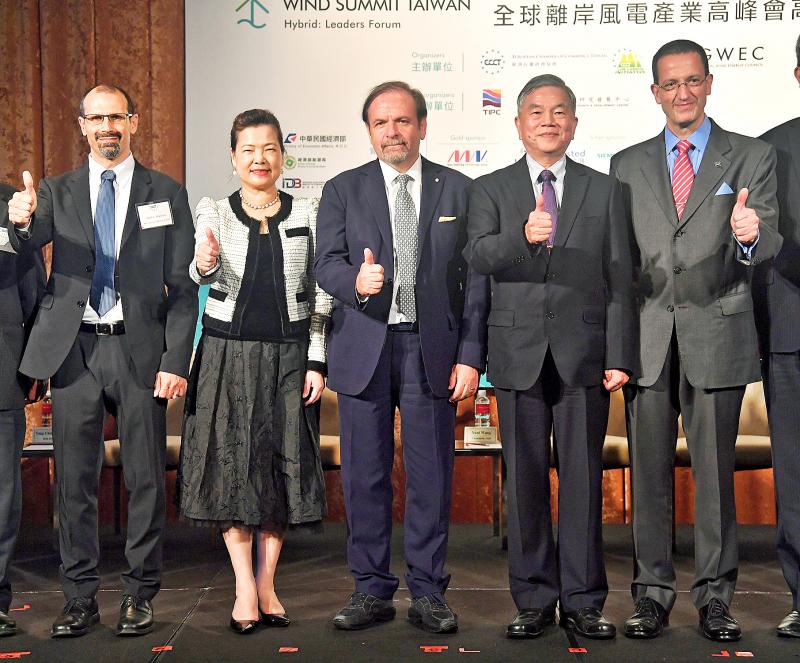Offshore wind farm developers and turbine makers yesterday asked for more flexibility in meeting the government’s localization requirements, as the framework for phase 3 of Taiwan’s offshore wind power development is being finalized.
Taiwanese suppliers also “need competition” to become viable exporters, industry leaders said in Taipei at the Global Offshore Wind Summit Taiwan Virtual 2020.
The localization policy requires international developers to source a number of components from Taiwanese suppliers.

Photo: CNA
“We’ve had some very good and successful experiences with Taiwanese companies where localization makes a lot of sense,” said Niels Steenberg, executive general manager for Offshore APAC for Siemens Gamesa Renewable Energy (SGRE).
“Unfortunately on the other side of the coin we’ve been approached by companies who just want short-term profits,” he said.
The lack of competition for certain components among local companies makes it impossible to cut costs, Steenberg said.
“We’re creating Taiwanese single-source companies,” he said. “Export will be non-existent if we end up with an ‘island solution,’ where the individual suppliers are the only suppliers in the supply chain.”
Wpd Taiwan Energy Co (達能能源) chairwoman Yuni Wang (王雲怡) said giving developers “more choice” in how they fulfill the requirements would allow the government to achieve its goal of developing a local industry that can be competitive internationally.
“What we developers would like to see is more flexibility in the localization requirements. If we cannot make one component here, we can make another. If we do not have a choice, the supplier does not have any pressure to improve,” Wang said.
Bureau of Energy Director Yu Chen-wei (游振偉) told the forum that the concerns of international partners are being heard.
“I would like to thank our international partners for their feedback. It is the only way for local businesses to be aware of their flaws,” Yu said. “I know we have a lot of issues in front of us.
The government is still finalizing the draft of the framework that would govern how phase 3 of Taiwan’s wind power development plan is structured, which includes an average annual offshore wind capacity of 1 gigawatt that would be released between 2026 and 2030.
“We hope to create the most friendly and reasonable rules of the game,” Yu said.
Another concern about Taiwan’s plan of becoming a regional exporter is the possibility that other Asia-Pacific countries such as South Korea, Japan and Vietnam would introduce their own localization requirements as they develop their own offshore wind farms.
“We don’t want everybody protecting their own supply chain,” Orsted Asia-Pacific president Matthias Bausenwein said. “If we see item-based frameworks in every market, we will not create the volume needed to fill the factories.”
However, Taiwan still has the advantage of having been the first mover on wind power in the region, Bausenwein said, making it the “front-runner.”
“The decisive factor in the early days that made it possible to invest was because the framework became very clear,” Bausenwein said. “It wasn’t the feed-in-tariff that attracted investors, it was clarity.”
“It’s important to create clarity in the framework going forward. The supply chain is asking for clarity to continue or trigger further investments,” he added.
Taiwan’s offshore wind power industry is projected to be 59 terawatt-hours annually by 2035, reducing carbon emissions by 32.7 million tonnes per year, Yu said.
It is forecast to create an estimated 57,000 jobs, with foreign and domestic investment projected to exceed NT$2.6 trillion (US$89.84 billion), he said.

CHIP RACE: Three years of overbroad export controls drove foreign competitors to pursue their own AI chips, and ‘cost US taxpayers billions of dollars,’ Nvidia said China has figured out the US strategy for allowing it to buy Nvidia Corp’s H200s and is rejecting the artificial intelligence (AI) chip in favor of domestically developed semiconductors, White House AI adviser David Sacks said, citing news reports. US President Donald Trump on Monday said that he would allow shipments of Nvidia’s H200 chips to China, part of an administration effort backed by Sacks to challenge Chinese tech champions such as Huawei Technologies Co (華為) by bringing US competition to their home market. On Friday, Sacks signaled that he was uncertain about whether that approach would work. “They’re rejecting our chips,” Sacks

NATIONAL SECURITY: Intel’s testing of ACM tools despite US government control ‘highlights egregious gaps in US technology protection policies,’ a former official said Chipmaker Intel Corp has tested chipmaking tools this year from a toolmaker with deep roots in China and two overseas units that were targeted by US sanctions, according to two sources with direct knowledge of the matter. Intel, which fended off calls for its CEO’s resignation from US President Donald Trump in August over his alleged ties to China, got the tools from ACM Research Inc, a Fremont, California-based producer of chipmaking equipment. Two of ACM’s units, based in Shanghai and South Korea, were among a number of firms barred last year from receiving US technology over claims they have

It is challenging to build infrastructure in much of Europe. Constrained budgets and polarized politics tend to undermine long-term projects, forcing officials to react to emergencies rather than plan for the future. Not in Austria. Today, the country is to officially open its Koralmbahn tunnel, the 5.9 billion euro (US$6.9 billion) centerpiece of a groundbreaking new railway that will eventually run from Poland’s Baltic coast to the Adriatic Sea, transforming travel within Austria and positioning the Alpine nation at the forefront of logistics in Europe. “It is Austria’s biggest socio-economic experiment in over a century,” said Eric Kirschner, an economist at Graz-based Joanneum

BUBBLE? Only a handful of companies are seeing rapid revenue growth and higher valuations, and it is not enough to call the AI trend a transformation, an analyst said Artificial intelligence (AI) is entering a more challenging phase next year as companies move beyond experimentation and begin demanding clear financial returns from a technology that has delivered big gains to only a small group of early adopters, PricewaterhouseCoopers (PwC) Taiwan said yesterday. Most organizations have been able to justify AI investments through cost recovery or modest efficiency gains, but few have achieved meaningful revenue growth or long-term competitive advantage, the consultancy said in its 2026 AI Business Predictions report. This growing performance gap is forcing executives to reconsider how AI is deployed across their organizations, it said. “Many companies